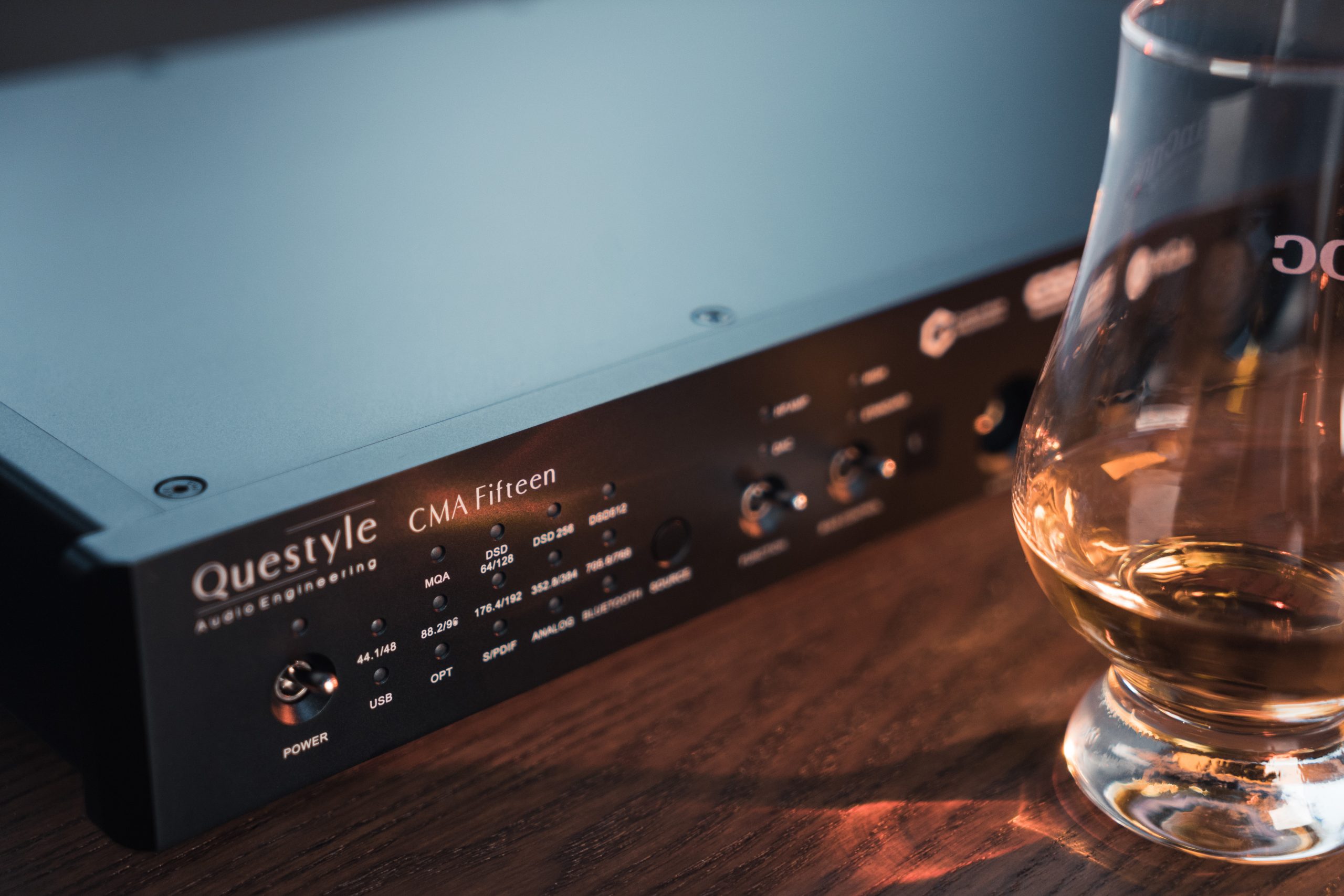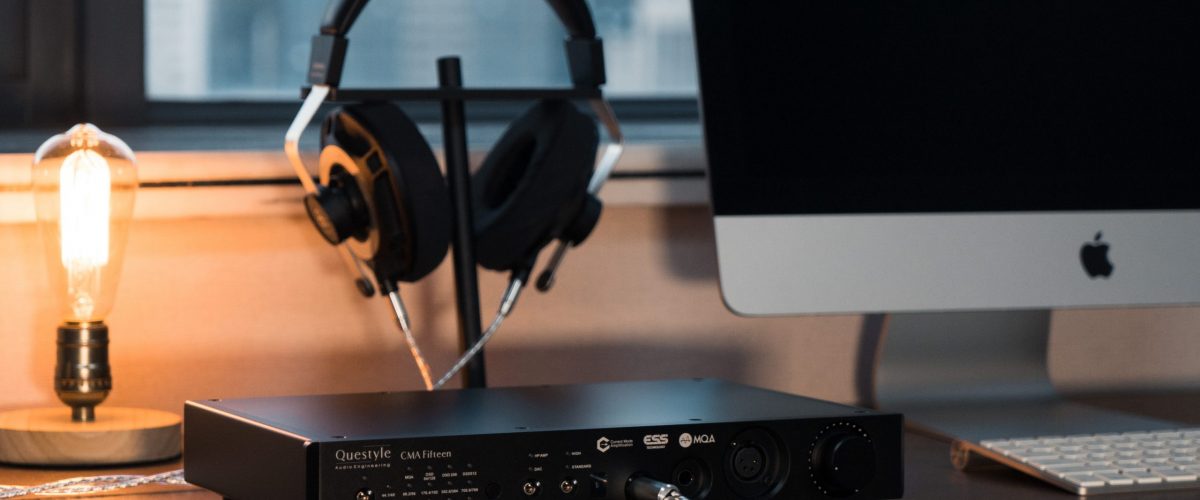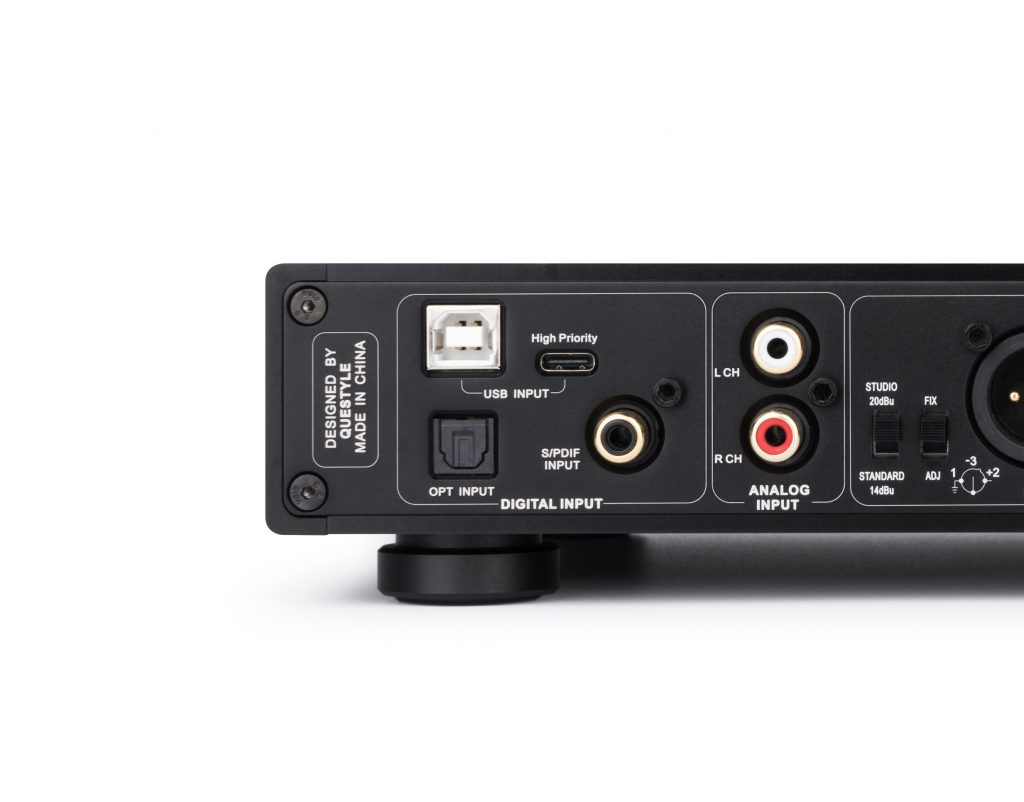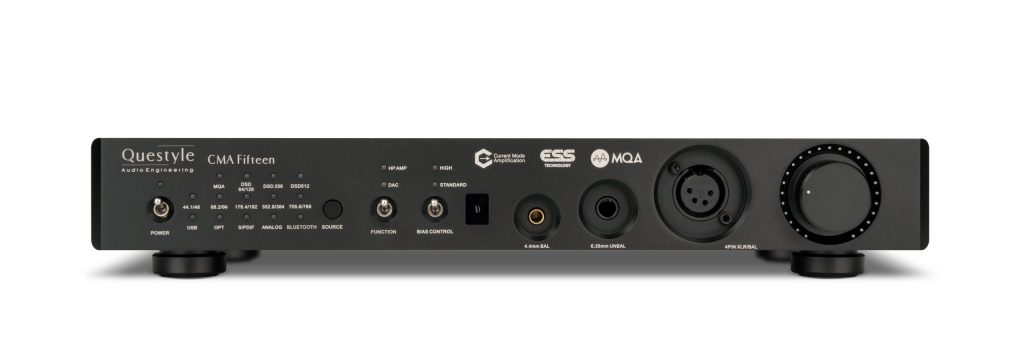Disclaimer:
Questyle has kindly approached me to review their flagship DAC/amp, the CMA Fifteen. I happily agreed as being a headphone listener this is a unit that drew my attention anyway. I am not affiliated with Questyle to any degree.
Background and a little Questyle history:
Questyle was founded in 2012 in China. It is a company that takes quality control and quality in general very seriously and the innovation of their engineers was acknowledged by many international awards including CES. Their design philosophy is based around amplifying current instead of voltage; the opposite of what most amplifiers do. I will touch on this technology a little later. Their first amplifier was the CMA800i which was an immense success. They started at the higher end of the market, the technology then trickled down to more affordable consumer pieces like the CMA600i, CMA400i and with further developments they released the CMA12 and last year the CMA15.
I used to own the CMA600i which I quite enjoyed back then, its weak point was the DAC section which in my opinion held back the overall performance. With an external DAC like Chord Qutest I had achieved great results until eventually moved on to better amplifiers. I remember the CMA600i being quite a smooth listen.
What is current amplification then?
I am very far from understanding it fully and I am not an engineer at all, but I will try to sum up what I read about it here and there.
Voltage is the electrical force that drives the current between two points. Current is the rate of flow of the electric charge. Apparently it is easier and more cost effective to amplify the voltage of an electric signal, that is why most amplifiers are designed this way. The disadvantage of amplifying voltage is that the original, very weak signal gets slightly distorted during the amplification process. Think of it like projecting a picture to the wall on an old overhead projector: the picture gets a lot bigger, but also a little distorted.
On the other hand if the current rate gets amplified/increased, the original, weak signal remains undistorted, just the flow rate gets boosted which also leads to a stronger and louder result. This can't be done on speakers as the technology has physical limitations, but current amplification can be powerful enough to drive the small and efficient headphone drivers/transducers. Current amplification effectively is an alternative signal management which aims to preserve a cleaner signal and reproduce a more accurate sound in headphones.
In my opinion all higher end gear including amps, DACs and headphones have one main purpose and that is to sound as realistic and lifelike as possible. In my experience there are three main ways to achieve a more lifelike sound in your system. The most obvious is to buy higher end headphones, as they tend to sound a lot more lifelike with more natural texture. The second and third ways are R2R DACs and tube amps. It is not an accident that most long term, hard core audiophiles end up with one or both of them. The fourth, additional way of achieving a more natural sound could well be current amplification to a smaller extent. To me current amplification definitely has some more lifelike qualities compared to many regular voltage amplifiers. Not quite like a tube amp or R2R DAC, but a step towards a more realistic sound. Of course, there are gains and drawbacks of most R2R DACs and tube amps too, unless you go super high-end.
ESS DAC?
In the CMA15 there is an ESS chip which is known to be very technical but quite sharp sounding. I do not believe in 'chip sound' and you shouldn't either. The DAC's sound is all about implementing that chip in the audio circuit. Implementation can change the prejudged character of a DAC chip as it does in the CMA15. The CMA15 certainly has some treble energy, but the sound is still smooth and not bright/sharp or edgy at all. (Another example is the iFi Pro iDSD with Burr-Brown chips. Those chips are known for a warm and less technical sound and the Pro iDSD is a very detailed and technical DAC.)
Design, build quality:
The unit is surprisingly heavy for its size, but that is mostly due to the thick high grade aluminium casing which prevents all sorts of signal interferation. Build quality is up to a high standard, I particularly like the satisfying click of the switches on the front. Beauty is subjective, but I personally like the compact studio/industrial look of this Questyle flagship.
Sound:
I tried several DAC and amp combinations in the last few months which are still vivid in my mind, but do not have them anymore for direct comparison. Just to mention a few: Burson Soloist 3XP, Bryston BHA-1, iFi Pro iCan Signature, Chord Qutest, RME ADI-2, Soekris 2541. I combined all of these with each other back and forth.
What I have right now is the Chord TT2. I know, when it comes to new prices or even at secondhand prices the TT2 cost twice as much as the CMA15 but still I think this can be an interesting comparison although perhaps not quite fair. (I also have an older generation iFi Pro iCan at hand.)
General impressions:
Part of the reason I was interested in the CMA15 is to potentially replace my TT2 and use the extra cash elsewhere. The raving reviews of the Questyle and reading about another Head-Fier who swapped his TT2 for the CMA15 made me interested.
The sound of the CMA15 positively surprised me in some ways and slightly disappointed in others. Due to the delta/sigma ESS DAC I was expecting a brighter, edgier sound and a more two dimensional soundstage. I was surprised to hear that the soundstage has a lot more depth to it than I was expecting. More depth than on other delta/sigma DACs like the excellent RME ADI-2 for example. The width however is not actually that great on the CMA15 to my ears. Yes, sometimes you can hear sounds from far left or far right, but generally it feels like there are two big walls on my sides that somehow prevent the stage from expanding horizontally: I sense some unevenness in the CMA15's soundstage width.
This is a very neutral sounding DAC/amp it is not leaning to any direction, like most other equipment do. It is not a little bit warm, it is not a little bit bright: it is pretty much dead neutral. That can be a good thing in many users' books, but if someone is after a little extra flavour, might have to look elsewhere.
Technicalities:
I think the CMA15 offers a technical performance level akin to the competitors in its price range. The asking price is between £2200-£2500 depending on where you order it from. For this money you can put together many different and exciting DAC and amp combinations, for example using the pieces I mentioned above. Most of those DAC and amp combinations will cost you around two grand. While I think the CMA15 certainly competes with them, it doesn't really stand out. To me the RME ADI-2 with the Burson Soloist 3XP (Super Charger & power amp mode) or the Chord Qutest with a secondhand Bryston BHA-1 can still sound more spacious, more dynamic, more refined and perhaps a little more exciting. Of course every combination has drawbacks too.
The biggest advantage of the CMA15 here is a neat all in one aluminium case as opposed to a relatively awkward stack.
Back to the CMA15's sound, further initial impressions apart from the shape of the soundstage and the neutrality are dynamism, and macro dynamics. These are both excellent on the flagship Questyle. I really enjoy that tangible bass impact and weight. It is not as crazy as it is on the Bryston BHA-1 or the iCan Pro Signature, but slightly more impactful than the Hugo TT2 on its own. If I could change one thing on the TT2 that would be just a little more bass impact.
The CMA15 sounds as detailed and resolution is as good as the price suggests.
Bass:
As I briefly touched on it already, bass is neutral but weighty and impactful with good slam and definition. Extension is as good as it gets. Notes are clean and well separated. Despite the dynamism the edges are not too sharp, they are slightly rounded. I think this is a characteristic of the current amplification as it pretty much describes the whole frequency range. While I really like a healthy and kicking bass, sometimes I was wishing for just a hint of warmth or extra smoothness.
Mids:
Mids are clear and well defined again with plenty of detail. They sound smooth(ish), but they are not as lifelike as they can be. The singer's position is great, mids are not recessed and not too forward either. Both in a spatial and in a frequency range kind of sense mids are in line and in balance with the rest of the sound. If I had to criticise mids on the CMA15 I would say they are a little too 'studiolike' to my taste. They sound like a great studio recording as opposed to a live performance or even live recording. Vocals are not as engaging as they can be.
Treble:
Treble is clean and clear with good air. While it is still in balance with the rest of the sound, there is certainly a strong treble presence. It adds to the perception of space and details, and I wouldn't say it is overly bright or sharp despite using the ESS chip. Yet, to me this treble openness combined with the dynamic presence both in treble and bass led to slightly more fatiguing long term listening sessions. It is fun and enjoyable in the first two hours, but then if I switch to my TT2, my ears sigh a smaller relief.
Few more thoughts on sound and comparing to Hugo TT2:
Let's sum up: to me the CMA15 sounds like a neutral, dynamic studio equipment with good detail retrieval and resolution for the price. Current mode smoothes off the edges, but to me the sound is not quite fluid and effortless enough for long listening sessions.
When it comes to multi thousand dollar audio equipment, let it be headphones, amplifiers or DACs, it is common knowledge that performance will improve to smaller and smaller degrees as you throw in another grand and another grand. A $4000 headphone will not sound twice as good as a $2000 pair. But it is almost certain, they will sound better: more spacious, more lifelike, more coherent with better timbre and texture in most cases. Budget, hearing abilities, needs, wishes and taste all play a big role whether someone wants to buy a $4000 headphone or stay happy with a $2000 pair. Improvements might be incremental to some, but enormous to another. It is a subjective hobby on many levels.
To me the Hugo TT2 sounds not simply smooth, but significantly more fluid and coherent. Music effortlessly flows with the TT2. Compared to the CMA15 the level of micro details and micro dynamics are a clear step up, Chord's desktop DAC/amp sounds more lifelike, the space is a lot bigger in all directions, instrument separation in this bigger space is more effortless and cleaner as well.
The CMA15 in comparison can get a little congested at very busy passages whereas the TT2 handles these with ease. The information of the surroundings, feeling the venue from tiny spatial cues is clearly present on the TT2; to a much lesser extent on the CMA15. Drum hits are notoriously difficult to reproduce in a lifelike manner. A drum hit is a short but intense and complex signal. Many amplifiers get the leading edge right, giving the impression of a dynamic sound. Not too many amplifiers excel at reproducing drum hit decay, body and reverbs. Upper mids and lower treble is much more open and airy on the TT2 which leads to a more natural sound perception.
When comparing the CMA15 to similarly priced DAC and amp combinations, these differences of course will be less obvious if apparent at all.
Occasionally the Questyle can also come across as a little dry. While the TT2 is not as organic and lifelike as a good R2R DAC, Rob Watt's FPGA design with the increased taps puts chord DACs somewhere between regular delta/sigma and R2R when it comes to lifelikeness and three dimensionality.
I still think the CMA15 is a great two in one unit, and I am aware that comparing it to the TT2 is unfair. Yet based on my research, the overwhelmingly positive reviews on Head-Fi led me to think the battle will be a little tighter.
In my opinion, you should have something to love in every audio equipment you own, even in the most neutral sounding ones. Most, neutrally categorized equipment lean just a little bit towards warmth or brightness. Some excel at presenting accurate texture, some are very coherent, others are supremely smooth. Some are very lifelike or open and airy sounding. Some are extra dynamic and slam hard. Depending on your taste, you love your chosen 'neutral' gear for a reason. I find that on the CMA15 there is not actually too much to criticise from an objective perspective. It is a neutral, dynamic studio sound, a neat 'two in one' solution. My issue is, there is not much about the CMA15's sound to get particularly excited about either, let alone evoking emotions. Still, if you come from some more affordable Schiit stacks, basic THX, SMSL or Topping combos, there is a good chance the CMA15 will wow you.
Conclusion:
I do not like to share less glowing reviews, but I have to stay honest to my ears. I still think the CMA15 is a very decent and good DAC/amp, but I also think that with separate DAC and amp combinations you can find a more pleasing and more enjoyable sound when it comes to the £2200-£2500 price range. Secondhand market is a different story, with some luck you can find a used CMA15 around £1400-£1500. For that money it certainly beats pretty much every other alternatives; but it is not a Hugo TT2 killer. At least not for me.
Bonus experiment:
After I finished the review I decided to try the CMA15's amp section only, using the Hugo TT2 as a DAC. This is a rather unlikely usage scenario, but based on my experience with the CMA600i/Qutest combo from a few years back, I wanted to hear what a higher end DAC brings out of the CMA15's amp section. Analogue input was missing from the last few Questyle DAC/amps since the CMA600i; it is back on the new flagship. For comparison purposes I used my old generation iFi Pro iCan strictly in single ended input mode to make the comparison more fair (balanced input is superior on the iCan).
As expected, the TT2 as DAC only to the CMA15 elevates and refines the sound of this unit. The Chord DAC enhances spaciousness and creates a more accurate 3D stage. The sound also gets smoother and more refined. The Questyle amp's character is preserved, it still sounds very neutral and a little dry especially compared to the iFi Pro iCan. The Questyle offers a little more space but I find the iFi more fun to listen to due to the extra weight, body, dynamics and slight warm colouration in its sound.























